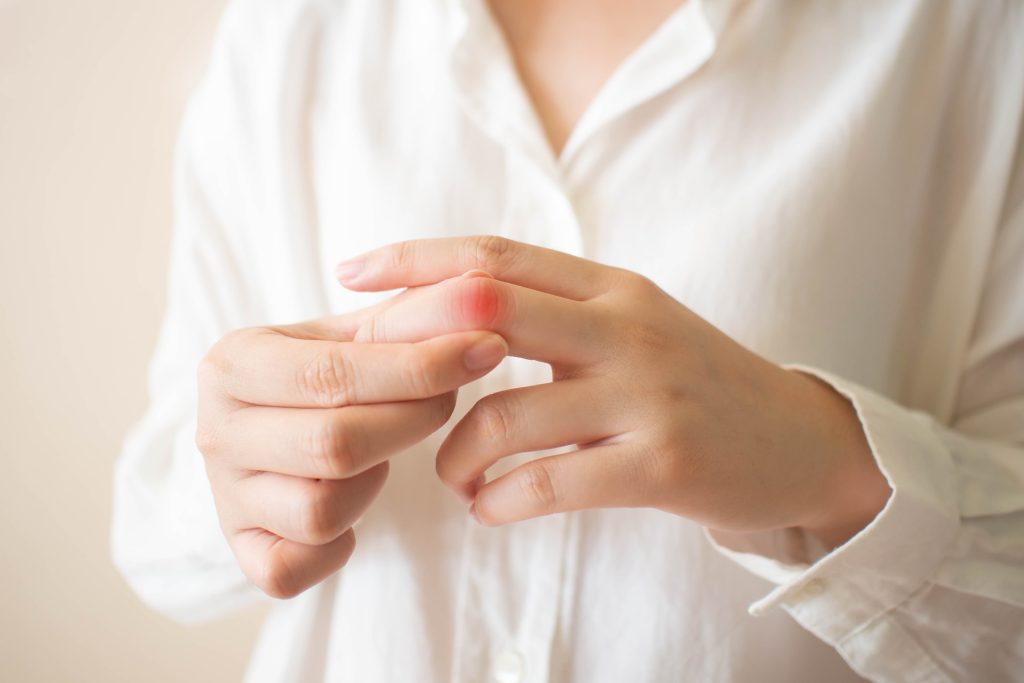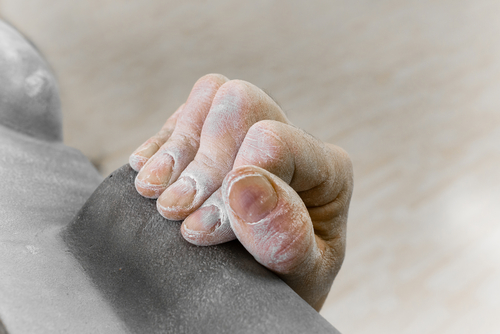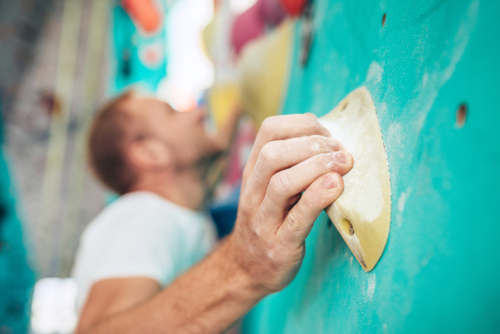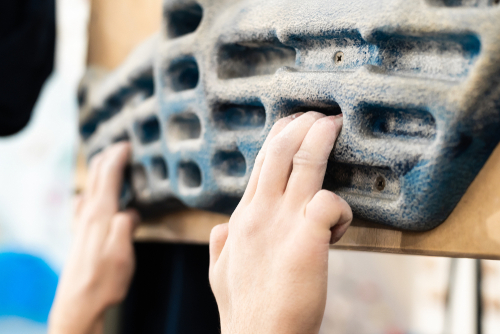Climbing and bouldering, sports that combine technique, strength, flexibility, and mental acuity, have gained immense popularity over recent years in Australia and across the world. Climbers tend to push their physical limits often, and at high intensities. Finger injuries in climbers account for approximately 41% of injuries due to the extreme forces exerted on these tissues. One such injury that climbers may encounter is finger joint synovitis/capulitis.
Finger joint synovitis is a condition characterised by inflammation of the synovial lining surrounding the proximal or distal interphalangeal (PIP/DIP, aka middle and end) joints of the finger.

Synovitis refers to the inflammation and potential thickening of the synovial membrane that envelops the inside of the joint capsule. This membrane is responsible for producing synovial fluid.
Repeated compressive forces, particularly when exceeding the cartilage’s capacity or causing depletion of synovial fluid, can trigger inflammation and subsequently increase synovial fluid production, further irritating the membrane.
In response to increased pressure within the joint capsule due to elevated synovial fluid levels, the body adapts by thickening the joint capsule and synovial membrane. This thickening enhances synovial fluid production even more so, perpetuating the cycle of inflammation and hypertrophy.
Causes of Finger Joint Synovitis
Finger joint synovitis in climbers often stems from overuse or repetitive stress on the fingers. Difficult climbing involves gripping smaller holds tightly, putting significant strain on the fingers. To be able to use smaller holds, climbers will use a ‘half crimp’ or ‘full crimp’ grip position to increase finger flexor leverage.
A half crimp involves flexion of the metacarpophalangeal joint (MCP) and the PIP joint with no hyperextension of the DIP joint.

A full crimp involves flexion of the MCP and the PIP joint and hyperextension of the DIP joint.

By using these grips repetitively, more stress is placed on the PIP & DIP joints, which can lead to microtrauma and inflammation of the synovial lining of these joints, especially when combined with additional rotational forces.
While symptoms can occur in any finger, it most commonly affects the ring finger and middle finger due to their increased length/leverage requirements when pulling on small flat holds (crimping).
Finger joint synovitis can also occur from acute trauma, due to finger twisting, abrupt loading of the finger joint or direct impact, although this is much less common.
Recognising Symptoms
Recognising the symptoms of finger joint synovitis early is crucial for prompt treatment and preventing further injury. Common symptoms include:
- Pain or tenderness around the DIP or PIP joint, especially during crimp grips while climbing or when bending the affected finger.
- Swelling or stiffness in the affected finger joint.
- Difficulty extending or flexing the finger smoothly.
Symptoms generally diminish with warm-up and moderate activity, mirroring symptoms of osteoarthritis.
If left untreated, finger joint synovitis can progress, leading to chronic inflammation and potentially causing longer-term impairments of the finger joints.
Treatment Options
Treatment for finger joint synovitis often involves load management first and foremost. Adjunct treatments can involve compression, gentle mobility, self mobilisations, and low-load exercises. Upon return to climbing, modifications and biomechanical variances should be considered to avoid re-injury.
For those who do not respond to conservative management, further medical intervention such as cortisone injection may be warranted. Speaking with a health professional who understands the demands of climbing and bouldering is recommended for treatment of these injuries.
Improvements in the affected joint can be determined by assessing range of motion (especially bending) and swelling (circumference of the affected joint), while also monitoring pain.
Here are some common approaches for treatment:
1. Rest
Giving the affected finger adequate rest from climbing is essential to allow inflammation to subside. For more significant cases, this may take several weeks.
2. Gentle compression
To assist in reducing acute inflammation to the affected joint, trialling the use of a self adhesive compression bandage (such as Coban tape) may be helpful. Wrap the finger from finger tip across the joint and below, providing mild compression without significantly limiting capillary return. Keeping compression on for extended periods is not recommended.
3. Mobility and Self Mobilisation Exercises
If comfortable, exercises focused on improving finger joint range of motion can be introduced. A favourite of these are tendon glides and gentle self distraction mobilisations. A simple (very light) ball squeeze is also possible.
Performing tendon gliding exercises can help improve flexibility and mobility in the fingers while also promoting tendon health. An example video of this exercise can be found here. Here’s how to perform a basic tendon glide exercise:
- Start Position: Begin by sitting or standing comfortably with your hand resting on a flat surface, palm facing down.
- Straight Finger Position: Extend all your fingers straight out, as if you were reaching for something. Keep your wrist in a neutral position.
- Make a Hook Fist: Bend only the large knuckles of your fingers while keeping the middle and end joints straight. Your fingers should form a hook-like shape.
- Make a Full Fist: Next, bend your fingers at all three joints to make a full fist, wrapping your thumb around your fingers. Keep your wrist in a neutral position.
- Straight Fist Position: Extend your fingers back out into a straight position, as if you were pointing at something. Your hand should be flat, with the fingers and thumb extended.
Repeat these movements in a smooth and controlled manner. It’s important to perform the exercise slowly and gently, avoiding any sudden or jerky movements or pain. Initially, it may not be possible to bend the affected joint very far without discomfort – this is also a way to measure progress in finger joint range of motion.
Performing finger joint distraction mobilisations involves gently pulling apart the joints of the finger to increase mobility and reduce stiffness. These should be pain-free. Here’s how to perform this technique:
- Prepare: Sit comfortably with your hand supported on a flat surface, such as a table. Ensure your hand is relaxed.
- Select a Finger: Choose the finger or joint you want to mobilise.
- Grasp the Finger: Use your opposite hand to grasp the selected finger just above the joint you wish to mobilise. The finger joint should be very slightly flexed.
- Apply Gentle Traction: With a gentle and steady force, pull the finger away from the hand, creating a distraction at the joint. Be sure not to apply too much force; it should be a gentle stretch.
- Hold and Release: Maintain the traction for about 5-10 seconds, allowing the joint to open up. Then, slowly release the traction. Repeat.
4. Modifying Climbing
It’s crucial to refrain from climbing or engaging in activities that exacerbate finger strain until the symptoms improve significantly. Returning to controlled climbing in more open-handed positions may be possible, but a high volume or high intensity of half or full crimp grip positions should usually be avoided until symptoms have settled.
6. Biomechanic considerations
Due to the repetitive nature of this injury, it is important to consider why there may be a bias towards specific joint overload. This is difficult to self assess but it usually comes back to habits of the climber. It may be a flow-on effect from a lack of wrist, forearm or shoulder range of motion or strength/control, or even a previous injury. Addressing these underlying limitations while off-loading the affected joint/s can be effective at reducing the risk of re-injury.
7. Hangboard Training
A lot of climbers seek to improve their finger strength by using a hangboard device off the wall. While there are symptoms of synovitis, any additional stress placed on the fingers joints by using these tools for higher intensity training is not recommended. Using them for a gentle warm up or in an open hand position may still be beneficial however, and improving non-aggravating grip positions can be encouraging to cross-train for the injured climber.

For more chronic cases of synovitis, while avoiding higher stress positions on the wall climbing, a protocol of ‘no-hangs’ or ‘regenerative hangs’ may be helpful to clear excess synovial fluid by increasing local blood flow. A no-hangs protocol involves keeping feet on the ground and holding onto grips of a hangboard at a low intensity (e.g. 30% of maximum). Using grip positions that provide variety to the joints are useful to recruit accessory muscles in the hand and fingers without further overstressing the joint in crimp or twisted positions. An example protocol may be 10 second holds every 30 seconds, repeating 10-20 times, rotating between many grip types (e.g. open, pinch, split fingers, pockets). Crimpd (phone app), has a basic protocol to follow along with.
8. Anti-inflammatory interventions
Given synovitis is an inflammatory condition, topical or oral anti-inflammatories under the guidance of a health professional may reduce symptoms more quickly. A natural supplement with anti-inflammatory properties to consider is curcumin (turmeric). For chronic synovitis symptoms that have failed conservative management per the above treatment strategies, a corticosteroid injection is indicated to improve the inflammation back to a ‘baseline’ prior to gradual reloading.
Prevention Strategies
Preventing finger joint synovitis in climbers is arguably more important than treatment. It involves adopting proper climbing techniques and incorporating preventive measures into a climbing routine:
1. Gradual Progression
Avoid overexertion and gradually increase the intensity and duration of climbing sessions to allow the fingers to adapt to the stress gradually. This is the most important aspect of managing synovitis for climbers. Monitor power loss and fatigue in the fingers and cease a session when this begins to occur. Similarly, reduce the overall attempts on high intensity climbs/boulders that involve awkward or unfamiliar grips. Using a training log or diary to track load tolerances and flare ups may be required in chronic synovitis.
2. Warm-Up
Prior to climbing, engage in a comprehensive warm-up routine that includes progressive hangboarding to prepare the fingers for the demands of climbing. Using a larger edge for this will reduce stress on the finger joints.
A tool gaining more popularity to load the fingers off the wall is a variation of a hangboard called an unlevel edge. Traditional hangboards can place more stress on the longer finger joints due to the increased PIP joint flexion angles required. An unlevel edge uses a stepped design to try to approximate PIP joint loading to 90 degrees on each finger. Examples of unlevel edge device suppliers as of 2024 are Head to toe 3D (US) and Process Physiotherapy (UK).
Individual warm ups will vary depending on the level of ability, but a minimum of 10 x 5-10 second progressive hangs prior to climbing is a starting point.
3. Proper Technique
Focus on using proper climbing techniques, such as open-handed grips or using the entire hand rather than relying solely on crimp positions. If you find you are relying on the crimp grip even on open handed holds, it could put you at more risk for synovitis. Consider body positions while climbing on crimp holds; ask yourself how you could avoid pulling so hard in that crimp grip position by adjusting the rest of your body.
4. Cross-Training
Consider cross-training activities such as resistance/weight training, or flexibility/stretching instead of higher volume climbing sessions. This will allow progression in other aspects of climbing, without overloading the fingers.
5. Listen to Your Body
Pay attention to any signs of discomfort or strain in the fingers and take appropriate rest to prevent overuse injuries. Consider how many sessions have had in past days, weeks or months, and how much your body should be able to handle. Maybe you are coming back to climbing from time away or injury.
6. Sleep, Nutrition, Stress, Inflammatory drivers
Consider external factors that may be contributing to an increased risk of inflammatory reactions or poor recovery. These may include a lack of sleep, poor diet, life stress and alcohol consumption.
Conclusion
Finger joint synovitis is a common injury among climbers, but with proper awareness, treatment and preventive measures, it can be managed effectively. By understanding the causes, recognising symptoms early and adopting strategies to prevent injury, climbers can continue to pursue their sport safely while minimising the risk of finger joint synovitis. Prioritising finger health is essential for long-term enjoyment and success in climbing. For more significant or longstanding synovitis symptoms, seeing a health professional who understands climbing injuries is recommended.
References
Brandt, N. (2023). Capsulitis and Synovitis Climbing – Swelling of the Fingers. The Climbing Doctor. https://theclimbingdoctor.com/swelling-of-the-finger-joints/
Hewlings, S. J., & Kalman, D. S. (2017, Oct 22). Curcumin: A Review of Its Effects on Human Health. Foods, 6(10). https://doi.org/10.3390/foods6100092
McVittie, A. (2022). Finger Care for Climbers. https://www.ukclimbing.com/articles/injuries/finger_care_for_climbers-14850
Schöffl, V., & Schöffl, I. (2007, 04/01). Finger pain in rock climbers: Reaching the right differential diagnosis and therapy. The Journal of sports medicine and physical fitness, 47, 70-78.
Schöffl, V., Schöffl, I., Frank, L., Küpper, T., Simon, M., & Lutter, C. (2020, 06/01). Tendon Injuries in the Hands in Rock Climbers:Epidemiology, Anatomy, Biomechanics and Treatment An Update. Muscle Ligaments and Tendons Journal, 10, 233. https://doi.org/10.32098/mltj.02.2020.08
Schöffl V, Schöffl I, Lutter C, Hochholzer T, editors. Climbing medicine: a practical guide. Springer Nature (2022).
Schweizer, A. (2001, Feb). Biomechanical properties of the crimp grip position in rock climbers. J Biomech, 34(2), 217-223. https://doi.org/10.1016/s0021-9290(00)00184-6
Vagy, J. (2023). Clinical management of finger joint capsulitis/synovitis in a rock climber. Front Sports Act Living, 5, 1185653. https://doi.org/10.3389/fspor.2023.1185653

